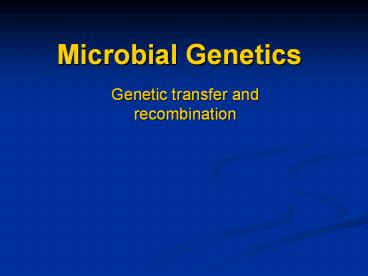Microbial%20Genetics - PowerPoint PPT Presentation
Title:
Microbial%20Genetics
Description:
Microbial Genetics Genetic transfer and ... is converted to a new donor cell Importance of plasmids ... Enhancing pathogenicity The E. coli strain causing infant or ... – PowerPoint PPT presentation
Number of Views:265
Avg rating:3.0/5.0
Title: Microbial%20Genetics
1
Microbial Genetics
- Genetic transfer and recombination
2
Genetic recombination
- Genetic recombination through sexual reproduction
is an important means of variation in eukaryotes - Prokaryotes do not have an equivalent process of
sexual reproduction - However, prokaryotes do have mechanisms by which
DNA can be transferred between strains of the
same species, or even between different species - Contributes to a populations genetic diversity
3
Gene transfer
- Vertical gene transfer
- Occurs during reproduction. Transfer of genes
from an organism to its offspring - Horizontal gene transfer
- Transfer of genes from one organism to another
within the same generation
4
Horizontal gene transfer
- Involves one way transfer from a donor cell to a
recipient cell - A recipient cell that incorporates DNA from the
donor is called a recombinant - Genes are transferred naturally between bacteria
by three mechanisms - Transformation DNA is transferred as naked DNA
- Conjugation DNA is transferred between bacteria
that are in contact with each other - Transduction DNA is transferred by a bacterial
virus (bacteriophage)
5
Homologous recombination
- DNA introduced into bacteria usually does not
have a mechanism to replicate itself - It relies on integration into the genome of the
host bacterium in order to survive and be passed
on
Incoming DNA
gene A
gene C
gene Z
Host genome
gene A
gene C
gene B
Recombinant genome
gene A
gene C
gene Z
6
Griffiths experiment, 1928Streptococcus
pneumoniae
7
Naked DNA
- When a bacterial cell lyses, it releases its DNA
into the environment
CENSORED!
8
Transformation
- DNA is transferred as naked DNA
- DNA breaks into pieces on cell lysis
- DNA is taken up by the recipient cell
- A region of the recipient DNA is replaced by the
donor DNA (recombination) - Unrecombined DNA is degraded
9
- Transformation occurs naturally in very few
genera of bacteria - Bacillus, Haemophilus, Neisseria, Acinetobacter,
and some strains of Streptococcus and
Staphylococcus. - The recipient cell must be in a physiological
state to take up DNA. - Changes in the bacterial cell wall make it
permeable to large DNA molecules - Some bacteria, which are not normally can be made
so in laboratory
10
Conjugation
- DNA transfer between two bacteria that are in
contact with one another - Contact between donor and recipient cells is
initiated by sex pili - DNA is transfer through a conjugation bridge or
open pore between donor and recipient cell - Mediated by a plasmid, called an F-factor
(fertility factor) or a conjugative plasmid
11
Plasmids
- Small, circular molecules of DNA
- Replicate independently of the chromosome
- Usually dispensable for growth, but under some
conditions provide a selective advantage such as
antibiotic resistance or a unique metabolic
pathway - Conjugative plasmids carry genes for conjugation
including sex pili
12
Mechanism of conjugation
- Donor contacts recipient, attaches using sex
pilus - F-factor initiates transfer of a copy of itself
- Recipient is converted to a new donor cell
13
Importance of plasmids
- Providing a selective advantage
- Some Pseudomonas sp. have plasmid encoded enzymes
to degrade petroleum allowing them to live in
fuel tanks or fuel spills - Enhancing pathogenicity
- The E. coli strain causing infant or travelers
diarrhea carries plasmids for toxin production
and bacterial attachment. - Antibiotic resistance
- Many antibiotic resistance genes are carried on
plasmids which can be rapidly transferred to
other bacteria, resulting in widespread
resistance to antibiotics and strains that
resistant to multiple antibiotics such as
methicillin-resistant Staphylococcus aureus or
Golden Staph
14
Transduction
- Mediated by a bacterial virus (bacteriophage or
phage) - DNA from the donor is transferred to the
recipient inside the phage particle - Two types of transduction
- Generalized
- Specialized
15
Generalized transduction
- Donor cell is infected with a phage
- Donor DNA is incorporated into the phage
(transducing phage) - The donor cell lyses
- The transducing phage infects the recipient cell
and injects the donor DNA - DNA integrated into the genome
16
Transposons
- Segments of DNA that can move from one region of
DNA to another and integrate through
non-homologous recombination - Contain information for their own transposition
- Transposase enzyme for cutting and resealing DNA
- Short terminal repeats which the transposase
recognizes as recombination sites
- Insertion sequences are the simplest transposons
- Complex transposons carry other genes e.g.,
antibiotic resistance genes
17
Natural history of a transposon
chromosome
transposon
plasmid
18
Genomes of bacteria are elastic
- Bacterial genomes are often receiving genetic
information from other bacteria through genetic
transfer and recombination - In the same way that mutations can be beneficial,
neutral or harmful, so is the recombination of
incoming DNA - New gene combinations are maintained if they
provide the organism with a selective advantage































